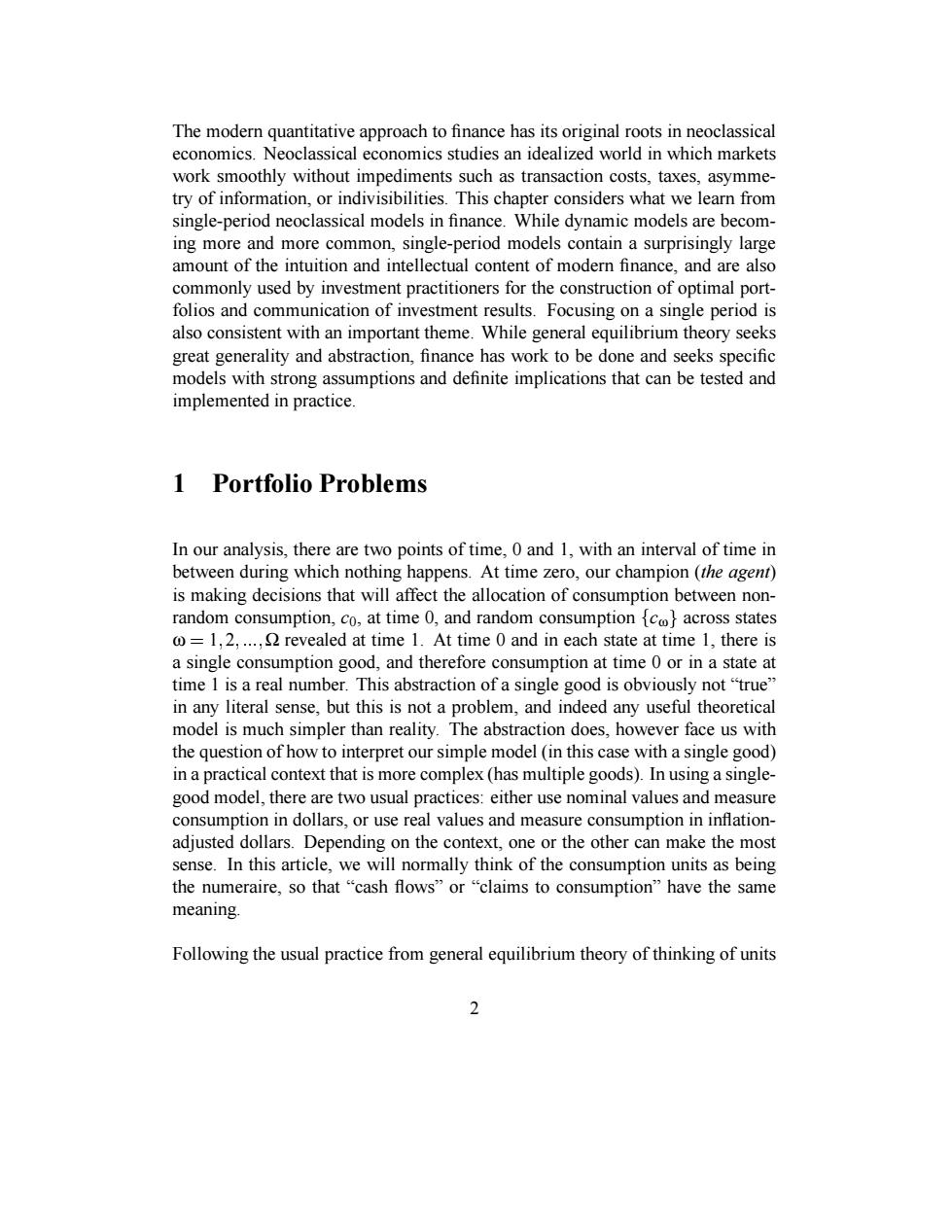正在加载图片...

The modern quantitative approach to finance has its original roots in neoclassical economics.Neoclassical economics studies an idealized world in which markets work smoothly without impediments such as transaction costs,taxes,asymme- try of information,or indivisibilities.This chapter considers what we learn from single-period neoclassical models in finance.While dynamic models are becom- ing more and more common,single-period models contain a surprisingly large amount of the intuition and intellectual content of modern finance,and are also commonly used by investment practitioners for the construction of optimal port- folios and communication of investment results.Focusing on a single period is also consistent with an important theme.While general equilibrium theory seeks great generality and abstraction,finance has work to be done and seeks specific models with strong assumptions and definite implications that can be tested and implemented in practice. 1 Portfolio Problems In our analysis,there are two points of time,0 and 1,with an interval of time in between during which nothing happens.At time zero,our champion (the agent) is making decisions that will affect the allocation of consumption between non- random consumption,co,at time 0,and random consumption fco}across states o=1,2,...,revealed at time 1.At time 0 and in each state at time 1,there is a single consumption good,and therefore consumption at time 0 or in a state at time 1 is a real number.This abstraction of a single good is obviously not"true" in any literal sense,but this is not a problem,and indeed any useful theoretical model is much simpler than reality.The abstraction does,however face us with the question of how to interpret our simple model(in this case with a single good) in a practical context that is more complex (has multiple goods).In using a single- good model,there are two usual practices:either use nominal values and measure consumption in dollars,or use real values and measure consumption in inflation- adjusted dollars.Depending on the context,one or the other can make the most sense.In this article,we will normally think of the consumption units as being the numeraire,so that“cash flows'”or“claims to consumption”have the same meaning. Following the usual practice from general equilibrium theory of thinking of units 2The modern quantitative approach to finance has its original roots in neoclassical economics. Neoclassical economics studies an idealized world in which markets work smoothly without impediments such as transaction costs, taxes, asymmetry of information, or indivisibilities. This chapter considers what we learn from single-period neoclassical models in finance. While dynamic models are becoming more and more common, single-period models contain a surprisingly large amount of the intuition and intellectual content of modern finance, and are also commonly used by investment practitioners for the construction of optimal portfolios and communication of investment results. Focusing on a single period is also consistent with an important theme. While general equilibrium theory seeks great generality and abstraction, finance has work to be done and seeks specific models with strong assumptions and definite implications that can be tested and implemented in practice. 1 Portfolio Problems In our analysis, there are two points of time, 0 and 1, with an interval of time in between during which nothing happens. At time zero, our champion (the agent) is making decisions that will affect the allocation of consumption between nonrandom consumption, c0, at time 0, and random consumption cω ✁ across states ω ✂ 1 ✄ 2 ✄✆☎✝☎✝☎✞✄ Ω revealed at time 1. At time 0 and in each state at time 1, there is a single consumption good, and therefore consumption at time 0 or in a state at time 1 is a real number. This abstraction of a single good is obviously not “true” in any literal sense, but this is not a problem, and indeed any useful theoretical model is much simpler than reality. The abstraction does, however face us with the question of how to interpret our simple model (in this case with a single good) in a practical context that is more complex (has multiple goods). In using a singlegood model, there are two usual practices: either use nominal values and measure consumption in dollars, or use real values and measure consumption in inflationadjusted dollars. Depending on the context, one or the other can make the most sense. In this article, we will normally think of the consumption units as being the numeraire, so that “cash flows” or “claims to consumption” have the same meaning. Following the usual practice from general equilibrium theory of thinking of units 2